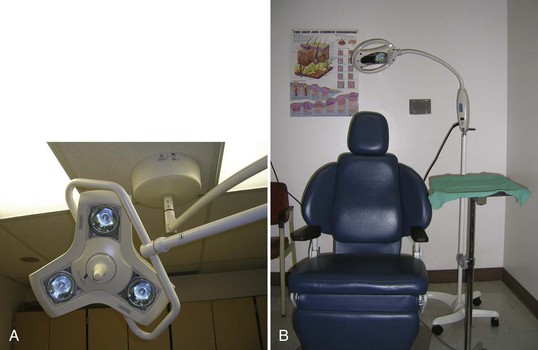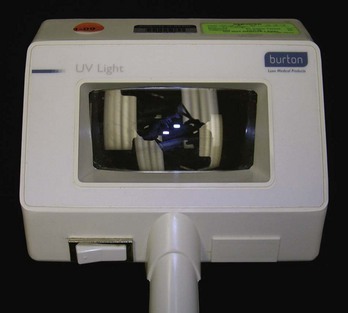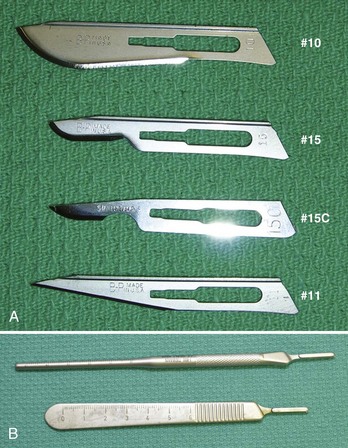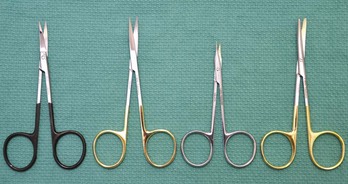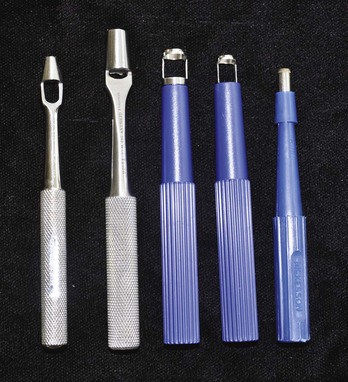2 Setting Up Your Office
Facilities, Instruments, and Equipment
Lighting
Surgical Lamps
Adequate lighting is best achieved by using surgical lamps that are either ceiling mounted or on a rolling base. There are many lamps from which to choose. We are pleased with the Burton Outpatient II light in our main procedure room (Figure 2-1A). It is very bright but does not get hot. This is Burton’s number one surgical light and is shadow free, can be focused, and is guaranteed to have a no-drift arm. We have found the light to be too bright at times so we have taped photo diffuser sheets over the lights. Another option is to put in a dimmer so you can control the light output. This light focuses with a central handle. The central handle can be covered with a sterile cover, but we just ask our medical assistant to reposition the light when needed. Many other lights are available, but it is worth getting a good one.
Floor Lamps
You should have at least one good-quality movable floor lamp for your exam rooms. One per room is optimal but one good movable lamp is a good start. Look for a lamp that provides excellent illumination, ease of movement, and stability in a small exam light for the floor. The Burton SuperNova exam light (Figure 2-1B) is one lamp that works well for us, but many other floor lamps are available that provide similar features. A gooseneck lamp with a bare incandescent light bulb gets hot and the light is not optimal for skin procedures.
Woods Lamp
The Woods lamp (Figure 2-2) uses an ultraviolet light and is useful for diagnosing or evaluating fungal infections including Microsporum canis and Malassezia furfur. It is also helpful for identifying the coral red fluorescence of erythrasma. It can be used for accentuating the hypopigmentation of vitiligo. In melasma, it is used to see if the hyperpigmentation is within the epidermal or dermal layer. Outside of dermatology the Woods lamp helps to diagnose corneal abrasions.
Surgical Table, Stools, and Mayo Stands
Each room should have a Mayo stand to hold surgical instruments during surgery (Figure 2-1B). Make sure these stands are stable and that the height can be adjusted. We prefer the ones with four or five wheels, rather than those with only two wheels.
Hand Instruments
Small surgical instruments can be categorized by their purpose in surgery, such as the following:
Cutting
Scalpels
A scalpel has two parts, the handle and blade. The four most useful blades (Figure 2-3A) for skin surgery are:
Blades are disposable and can be purchased separately or preattached to disposable plastic handles. The advantage of a totally disposable scalpel is that it eliminates the risk of being cut while attaching or removing a disposable blade from a nondisposable metal handle. The risk of being cut is low with good dexterity and experience. A needle holder or hemostat is helpful when placing a blade on the handle or taking it off. Blade-removal instruments can also be purchased. Although disposable scalpels are convenient, they are not as stable or as sharp as a metal scalpel handle with a disposable blade. For elliptical excisions and flaps, I prefer the sharp blades on a nondisposable metal handle. Special scalpel handles have been designed by surgeons for increased dexterity during more challenging surgeries (Figure 2-3B). Most metal scalpel handles come with a ruler marking for measuring the size of your surgical cuts (Figure 2-3B).
Razor Blades
The full range of razor blades (Figure 2-4) is discussed in detail in Chapter 9, The Shave Biopsy. The DermaBlade is a particularly easy and sharp blade to use for the novice and the expert. The Personna super double-edge blade is very sharp and can be broken in half for easy use. Although these do not come in sterile packaging, they can be used for shave biopsies without putting them through the autoclave. At pennies a blade, these are the most cost-effective tool for shave biopsies. They can be broken in half within their paper container to avoid cutting your hand prior to use.
Scissors
Figure 2-5 shows different types of scissors used in skin surgery. The most versatile and affordable scissor for snip excisions and cutting the base of a punch biopsy is the iris scissor, a small, sharp-tipped scissor that may be straight or curved. Use of the straight or curved iris is a matter of personal preference. The curved scissor is a bit more expensive and may allow the operator to get under a punch biopsy specimen with some ease. Scissor length varies from 3 to 5 in. The iris scissor can be used for suture removal and cutting sutures, but the ones used for this purpose should be kept separate from tissue-cutting scissors to avoid dulling your best surgical scissors. The iris scissor can also be used for blunt dissection and undermining. Scissors need periodic sharpening, but properly cleaned and treated instruments will generally last a long time and are worth the investment.
Many companies make specific undermining scissors with sharp or blunt tips and sharp blades. Some of these are tenotomy scissors or Metzenbaum scissors. These could be used instead of the all-purpose iris scissor. New technologies are being used to make the blades of scissors sharper. For a premium price you can now buy scissors that are as sharp as a scalpel (e.g., Supercut scissors). Endarterectomy scissors, which have a longer handle with blunt tips, also provide excellent control and precision for delicate work, but at a somewhat higher price.1
Punches
Punches come in sizes ranging from 2 to 10 mm. Clinicians may choose between disposable, one-use punches and reusable steel punches (Figure 2-6). Disposable punches are presterilized and need no maintenance. Reusable punches require cleaning and sterilization between procedures and must be sharpened periodically. We use disposable punches only because they are always sharp and convenient.

